Elizabeth Quay: Environmental, Economic, Socio-Cultural Impacts Report
VerifiedAdded on 2023/03/31
|6
|1406
|344
Report
AI Summary
This report, prepared for the Introduction to Hospitality and Tourism (TSM2202) course, examines the multifaceted consequences of tourism and hospitality, with a specific focus on the developmental project of Elizabeth Quay. The report begins with an introduction to the global significance of the tourism and hospitality sector, highlighting its economic contributions and projected growth. Part A delves into the environmental, economic, and socio-cultural impacts of the industry in general, detailing both positive and negative consequences. Part B applies these consequences to Elizabeth Quay, analyzing its environmental initiatives, economic contributions (job creation, investment), and socio-cultural effects. The report concludes with an evaluation of the long-term sustainability of Elizabeth Quay, considering its current practices and offering strategic recommendations for future development. The analysis incorporates references to relevant literature and data sources, providing a comprehensive assessment of the project's impact and sustainability.
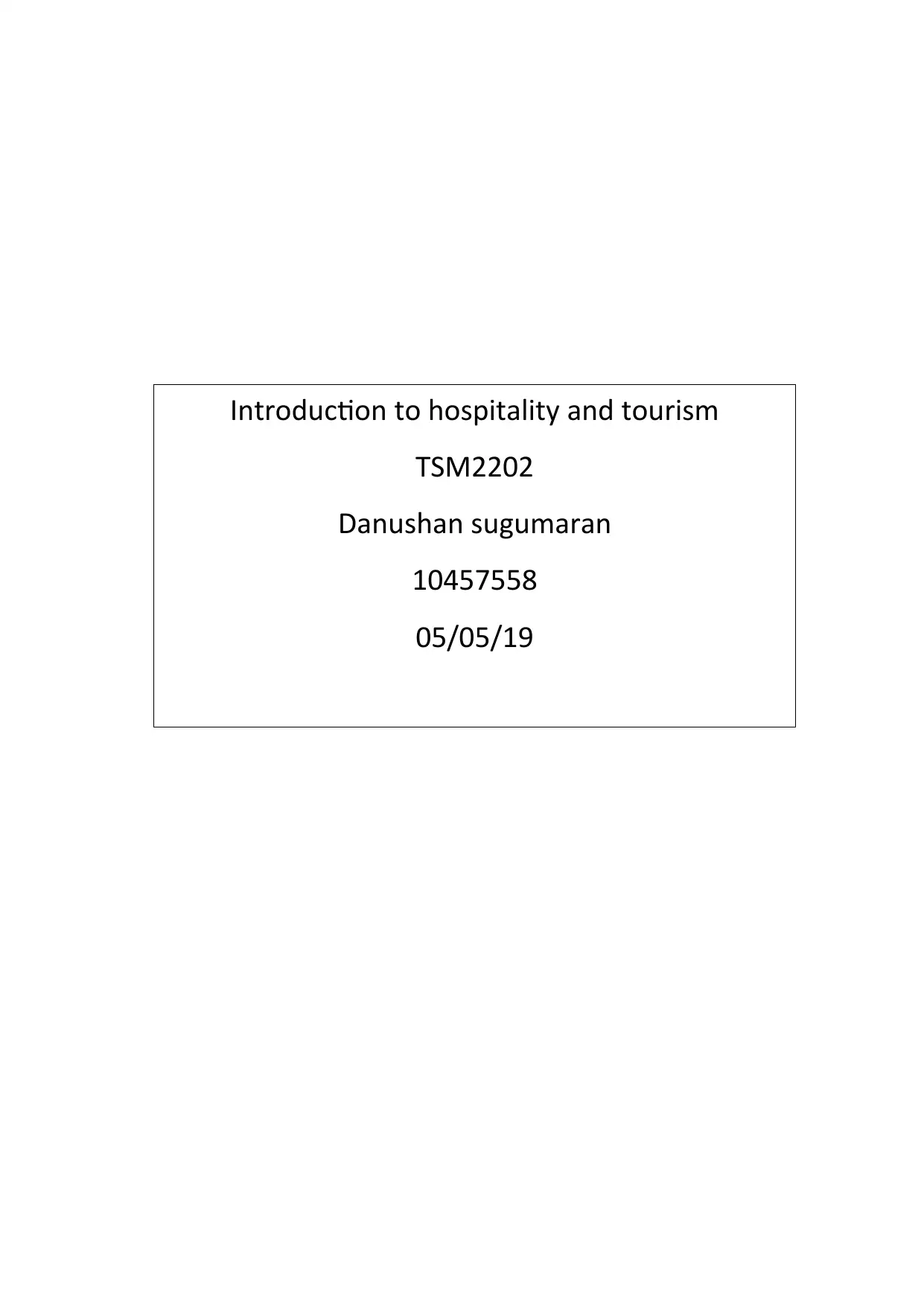
Introduction to hospitality and tourism
TSM2202
Danushan sugumaran
10457558
05/05/19
TSM2202
Danushan sugumaran
10457558
05/05/19
Paraphrase This Document
Need a fresh take? Get an instant paraphrase of this document with our AI Paraphraser
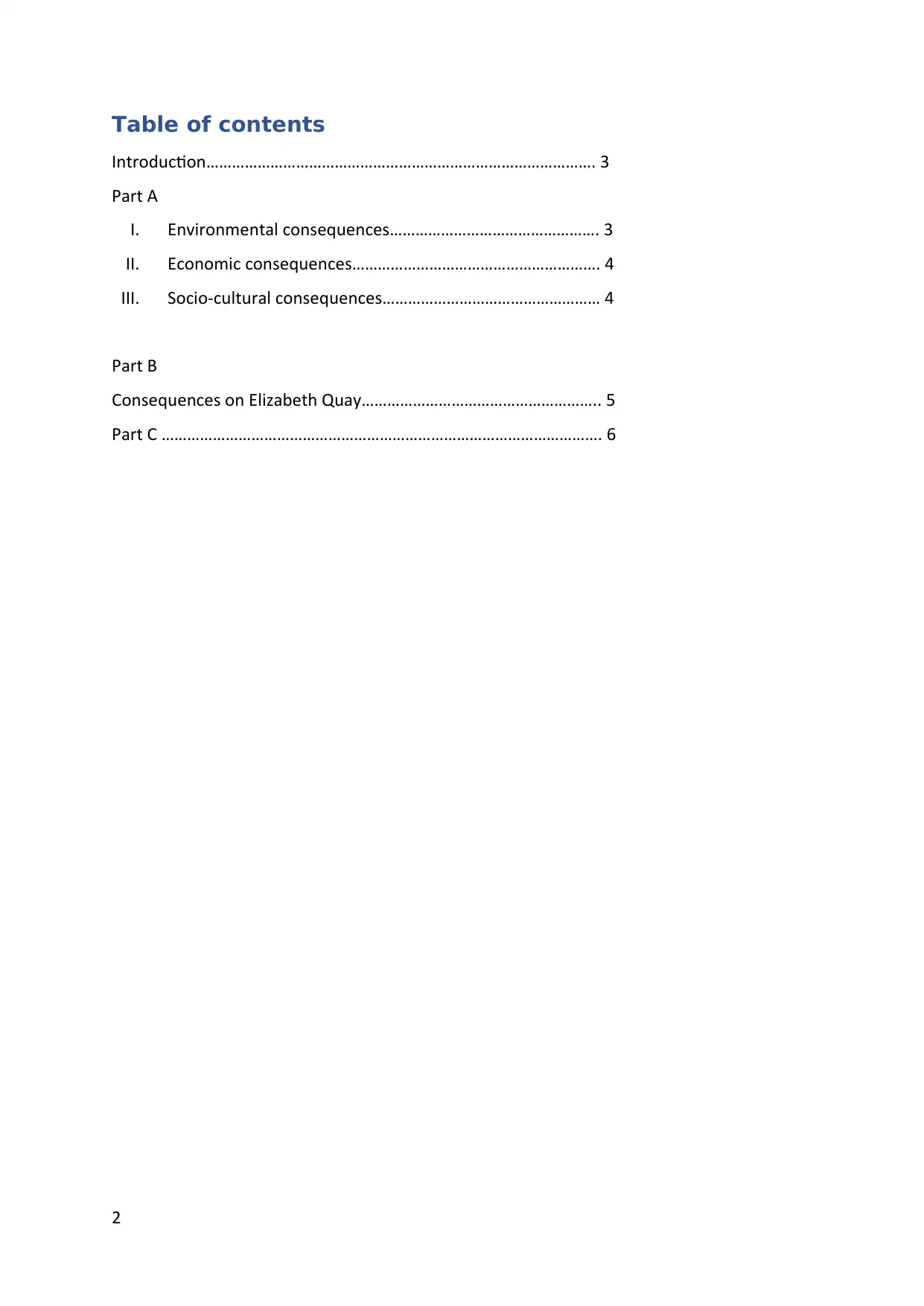
Table of contents
Introduction………………………………………………………………………………. 3
Part A
I. Environmental consequences…………………………………………. 3
II. Economic consequences…………………………………………………. 4
III. Socio-cultural consequences…………………………………………… 4
Part B
Consequences on Elizabeth Quay……………………………………………….. 5
Part C …………………………………………………………………………………………. 6
2
Introduction………………………………………………………………………………. 3
Part A
I. Environmental consequences…………………………………………. 3
II. Economic consequences…………………………………………………. 4
III. Socio-cultural consequences…………………………………………… 4
Part B
Consequences on Elizabeth Quay……………………………………………….. 5
Part C …………………………………………………………………………………………. 6
2
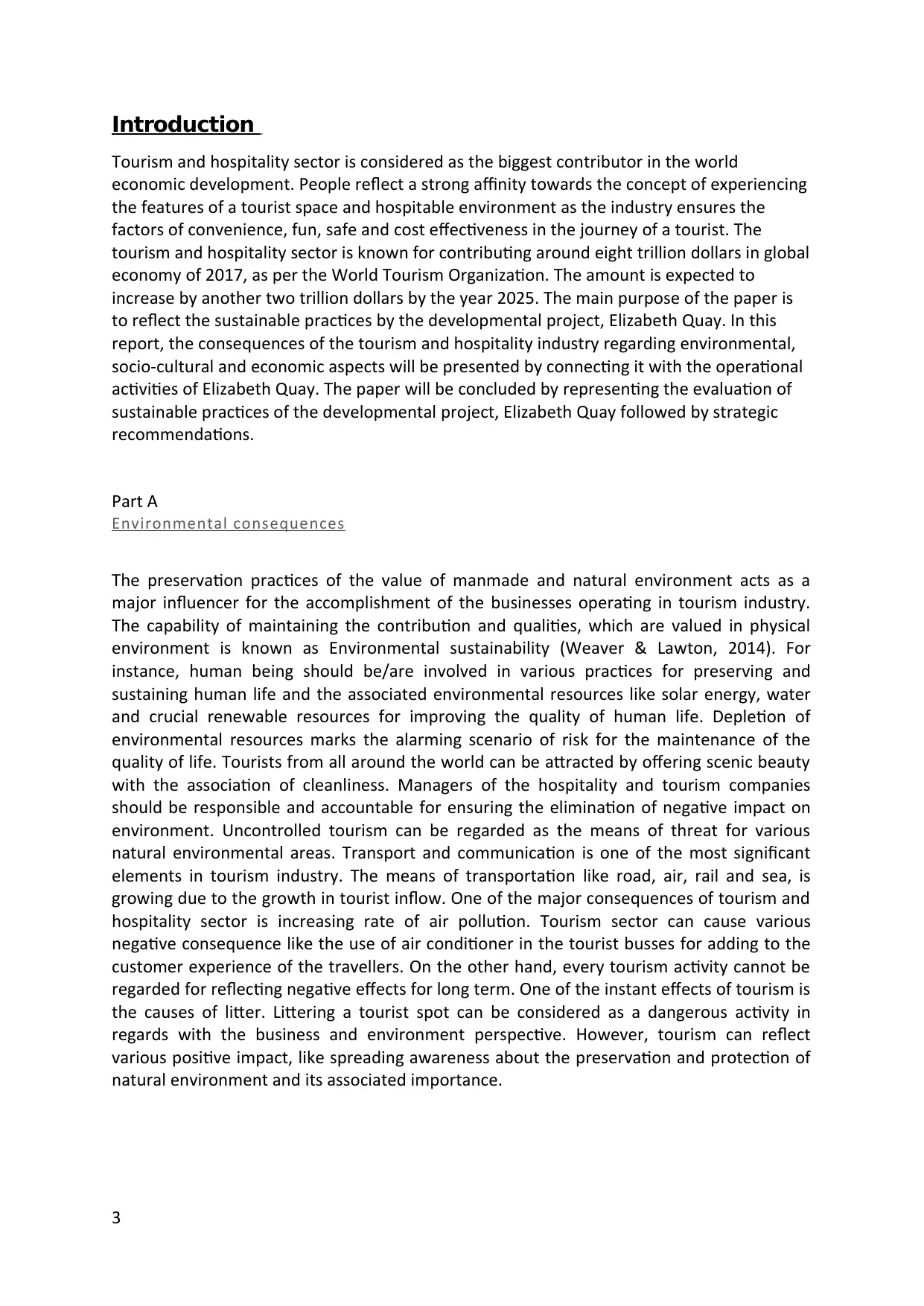
Introduction
Tourism and hospitality sector is considered as the biggest contributor in the world
economic development. People reflect a strong affinity towards the concept of experiencing
the features of a tourist space and hospitable environment as the industry ensures the
factors of convenience, fun, safe and cost effectiveness in the journey of a tourist. The
tourism and hospitality sector is known for contributing around eight trillion dollars in global
economy of 2017, as per the World Tourism Organization. The amount is expected to
increase by another two trillion dollars by the year 2025. The main purpose of the paper is
to reflect the sustainable practices by the developmental project, Elizabeth Quay. In this
report, the consequences of the tourism and hospitality industry regarding environmental,
socio-cultural and economic aspects will be presented by connecting it with the operational
activities of Elizabeth Quay. The paper will be concluded by representing the evaluation of
sustainable practices of the developmental project, Elizabeth Quay followed by strategic
recommendations.
Part A
Environmental consequences
The preservation practices of the value of manmade and natural environment acts as a
major influencer for the accomplishment of the businesses operating in tourism industry.
The capability of maintaining the contribution and qualities, which are valued in physical
environment is known as Environmental sustainability (Weaver & Lawton, 2014). For
instance, human being should be/are involved in various practices for preserving and
sustaining human life and the associated environmental resources like solar energy, water
and crucial renewable resources for improving the quality of human life. Depletion of
environmental resources marks the alarming scenario of risk for the maintenance of the
quality of life. Tourists from all around the world can be attracted by offering scenic beauty
with the association of cleanliness. Managers of the hospitality and tourism companies
should be responsible and accountable for ensuring the elimination of negative impact on
environment. Uncontrolled tourism can be regarded as the means of threat for various
natural environmental areas. Transport and communication is one of the most significant
elements in tourism industry. The means of transportation like road, air, rail and sea, is
growing due to the growth in tourist inflow. One of the major consequences of tourism and
hospitality sector is increasing rate of air pollution. Tourism sector can cause various
negative consequence like the use of air conditioner in the tourist busses for adding to the
customer experience of the travellers. On the other hand, every tourism activity cannot be
regarded for reflecting negative effects for long term. One of the instant effects of tourism is
the causes of litter. Littering a tourist spot can be considered as a dangerous activity in
regards with the business and environment perspective. However, tourism can reflect
various positive impact, like spreading awareness about the preservation and protection of
natural environment and its associated importance.
3
Tourism and hospitality sector is considered as the biggest contributor in the world
economic development. People reflect a strong affinity towards the concept of experiencing
the features of a tourist space and hospitable environment as the industry ensures the
factors of convenience, fun, safe and cost effectiveness in the journey of a tourist. The
tourism and hospitality sector is known for contributing around eight trillion dollars in global
economy of 2017, as per the World Tourism Organization. The amount is expected to
increase by another two trillion dollars by the year 2025. The main purpose of the paper is
to reflect the sustainable practices by the developmental project, Elizabeth Quay. In this
report, the consequences of the tourism and hospitality industry regarding environmental,
socio-cultural and economic aspects will be presented by connecting it with the operational
activities of Elizabeth Quay. The paper will be concluded by representing the evaluation of
sustainable practices of the developmental project, Elizabeth Quay followed by strategic
recommendations.
Part A
Environmental consequences
The preservation practices of the value of manmade and natural environment acts as a
major influencer for the accomplishment of the businesses operating in tourism industry.
The capability of maintaining the contribution and qualities, which are valued in physical
environment is known as Environmental sustainability (Weaver & Lawton, 2014). For
instance, human being should be/are involved in various practices for preserving and
sustaining human life and the associated environmental resources like solar energy, water
and crucial renewable resources for improving the quality of human life. Depletion of
environmental resources marks the alarming scenario of risk for the maintenance of the
quality of life. Tourists from all around the world can be attracted by offering scenic beauty
with the association of cleanliness. Managers of the hospitality and tourism companies
should be responsible and accountable for ensuring the elimination of negative impact on
environment. Uncontrolled tourism can be regarded as the means of threat for various
natural environmental areas. Transport and communication is one of the most significant
elements in tourism industry. The means of transportation like road, air, rail and sea, is
growing due to the growth in tourist inflow. One of the major consequences of tourism and
hospitality sector is increasing rate of air pollution. Tourism sector can cause various
negative consequence like the use of air conditioner in the tourist busses for adding to the
customer experience of the travellers. On the other hand, every tourism activity cannot be
regarded for reflecting negative effects for long term. One of the instant effects of tourism is
the causes of litter. Littering a tourist spot can be considered as a dangerous activity in
regards with the business and environment perspective. However, tourism can reflect
various positive impact, like spreading awareness about the preservation and protection of
natural environment and its associated importance.
3
⊘ This is a preview!⊘
Do you want full access?
Subscribe today to unlock all pages.

Trusted by 1+ million students worldwide
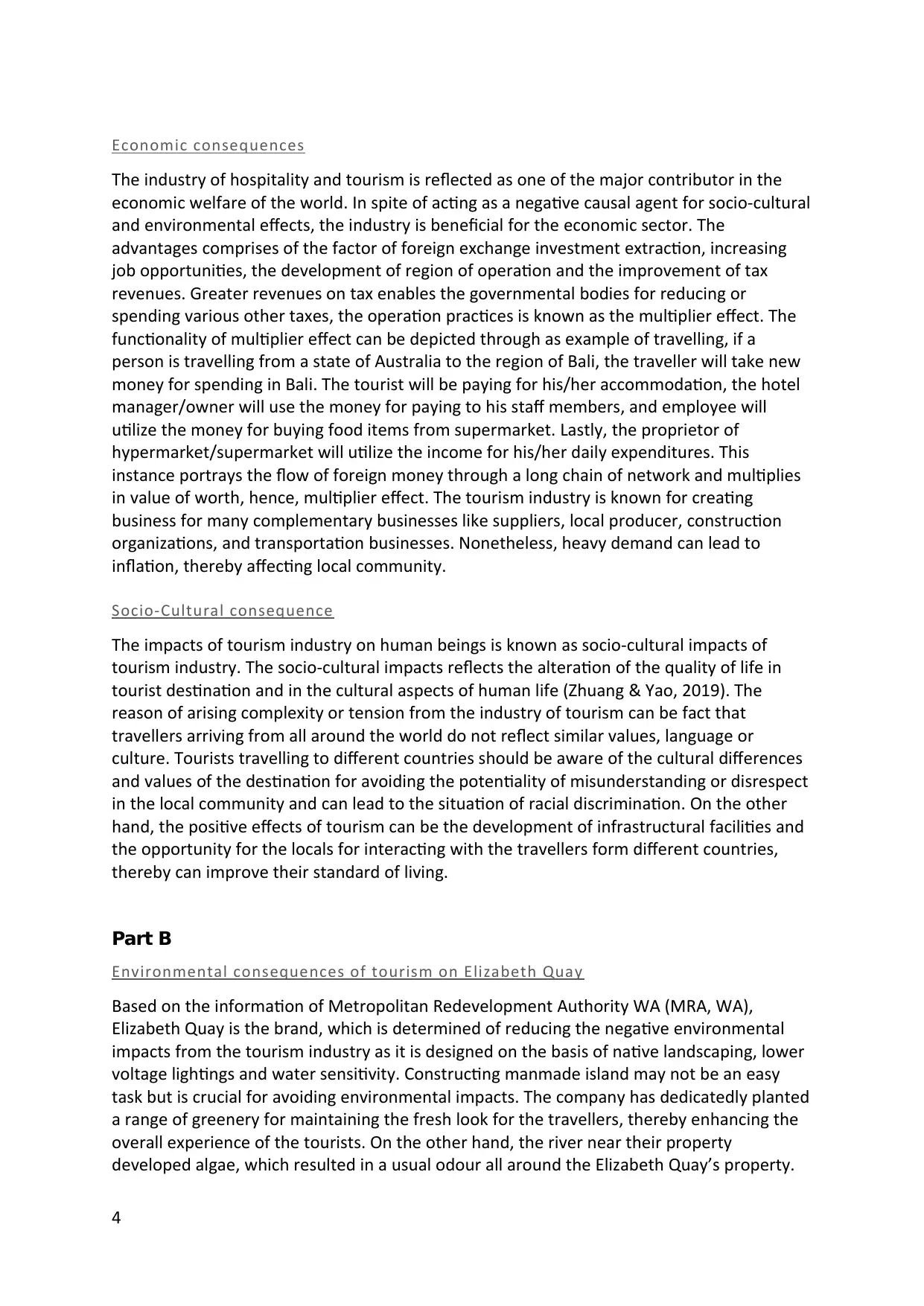
Economic consequences
The industry of hospitality and tourism is reflected as one of the major contributor in the
economic welfare of the world. In spite of acting as a negative causal agent for socio-cultural
and environmental effects, the industry is beneficial for the economic sector. The
advantages comprises of the factor of foreign exchange investment extraction, increasing
job opportunities, the development of region of operation and the improvement of tax
revenues. Greater revenues on tax enables the governmental bodies for reducing or
spending various other taxes, the operation practices is known as the multiplier effect. The
functionality of multiplier effect can be depicted through as example of travelling, if a
person is travelling from a state of Australia to the region of Bali, the traveller will take new
money for spending in Bali. The tourist will be paying for his/her accommodation, the hotel
manager/owner will use the money for paying to his staff members, and employee will
utilize the money for buying food items from supermarket. Lastly, the proprietor of
hypermarket/supermarket will utilize the income for his/her daily expenditures. This
instance portrays the flow of foreign money through a long chain of network and multiplies
in value of worth, hence, multiplier effect. The tourism industry is known for creating
business for many complementary businesses like suppliers, local producer, construction
organizations, and transportation businesses. Nonetheless, heavy demand can lead to
inflation, thereby affecting local community.
Socio-Cultural consequence
The impacts of tourism industry on human beings is known as socio-cultural impacts of
tourism industry. The socio-cultural impacts reflects the alteration of the quality of life in
tourist destination and in the cultural aspects of human life (Zhuang & Yao, 2019). The
reason of arising complexity or tension from the industry of tourism can be fact that
travellers arriving from all around the world do not reflect similar values, language or
culture. Tourists travelling to different countries should be aware of the cultural differences
and values of the destination for avoiding the potentiality of misunderstanding or disrespect
in the local community and can lead to the situation of racial discrimination. On the other
hand, the positive effects of tourism can be the development of infrastructural facilities and
the opportunity for the locals for interacting with the travellers form different countries,
thereby can improve their standard of living.
Part B
Environmental consequences of tourism on Elizabeth Quay
Based on the information of Metropolitan Redevelopment Authority WA (MRA, WA),
Elizabeth Quay is the brand, which is determined of reducing the negative environmental
impacts from the tourism industry as it is designed on the basis of native landscaping, lower
voltage lightings and water sensitivity. Constructing manmade island may not be an easy
task but is crucial for avoiding environmental impacts. The company has dedicatedly planted
a range of greenery for maintaining the fresh look for the travellers, thereby enhancing the
overall experience of the tourists. On the other hand, the river near their property
developed algae, which resulted in a usual odour all around the Elizabeth Quay’s property.
4
The industry of hospitality and tourism is reflected as one of the major contributor in the
economic welfare of the world. In spite of acting as a negative causal agent for socio-cultural
and environmental effects, the industry is beneficial for the economic sector. The
advantages comprises of the factor of foreign exchange investment extraction, increasing
job opportunities, the development of region of operation and the improvement of tax
revenues. Greater revenues on tax enables the governmental bodies for reducing or
spending various other taxes, the operation practices is known as the multiplier effect. The
functionality of multiplier effect can be depicted through as example of travelling, if a
person is travelling from a state of Australia to the region of Bali, the traveller will take new
money for spending in Bali. The tourist will be paying for his/her accommodation, the hotel
manager/owner will use the money for paying to his staff members, and employee will
utilize the money for buying food items from supermarket. Lastly, the proprietor of
hypermarket/supermarket will utilize the income for his/her daily expenditures. This
instance portrays the flow of foreign money through a long chain of network and multiplies
in value of worth, hence, multiplier effect. The tourism industry is known for creating
business for many complementary businesses like suppliers, local producer, construction
organizations, and transportation businesses. Nonetheless, heavy demand can lead to
inflation, thereby affecting local community.
Socio-Cultural consequence
The impacts of tourism industry on human beings is known as socio-cultural impacts of
tourism industry. The socio-cultural impacts reflects the alteration of the quality of life in
tourist destination and in the cultural aspects of human life (Zhuang & Yao, 2019). The
reason of arising complexity or tension from the industry of tourism can be fact that
travellers arriving from all around the world do not reflect similar values, language or
culture. Tourists travelling to different countries should be aware of the cultural differences
and values of the destination for avoiding the potentiality of misunderstanding or disrespect
in the local community and can lead to the situation of racial discrimination. On the other
hand, the positive effects of tourism can be the development of infrastructural facilities and
the opportunity for the locals for interacting with the travellers form different countries,
thereby can improve their standard of living.
Part B
Environmental consequences of tourism on Elizabeth Quay
Based on the information of Metropolitan Redevelopment Authority WA (MRA, WA),
Elizabeth Quay is the brand, which is determined of reducing the negative environmental
impacts from the tourism industry as it is designed on the basis of native landscaping, lower
voltage lightings and water sensitivity. Constructing manmade island may not be an easy
task but is crucial for avoiding environmental impacts. The company has dedicatedly planted
a range of greenery for maintaining the fresh look for the travellers, thereby enhancing the
overall experience of the tourists. On the other hand, the river near their property
developed algae, which resulted in a usual odour all around the Elizabeth Quay’s property.
4
Paraphrase This Document
Need a fresh take? Get an instant paraphrase of this document with our AI Paraphraser
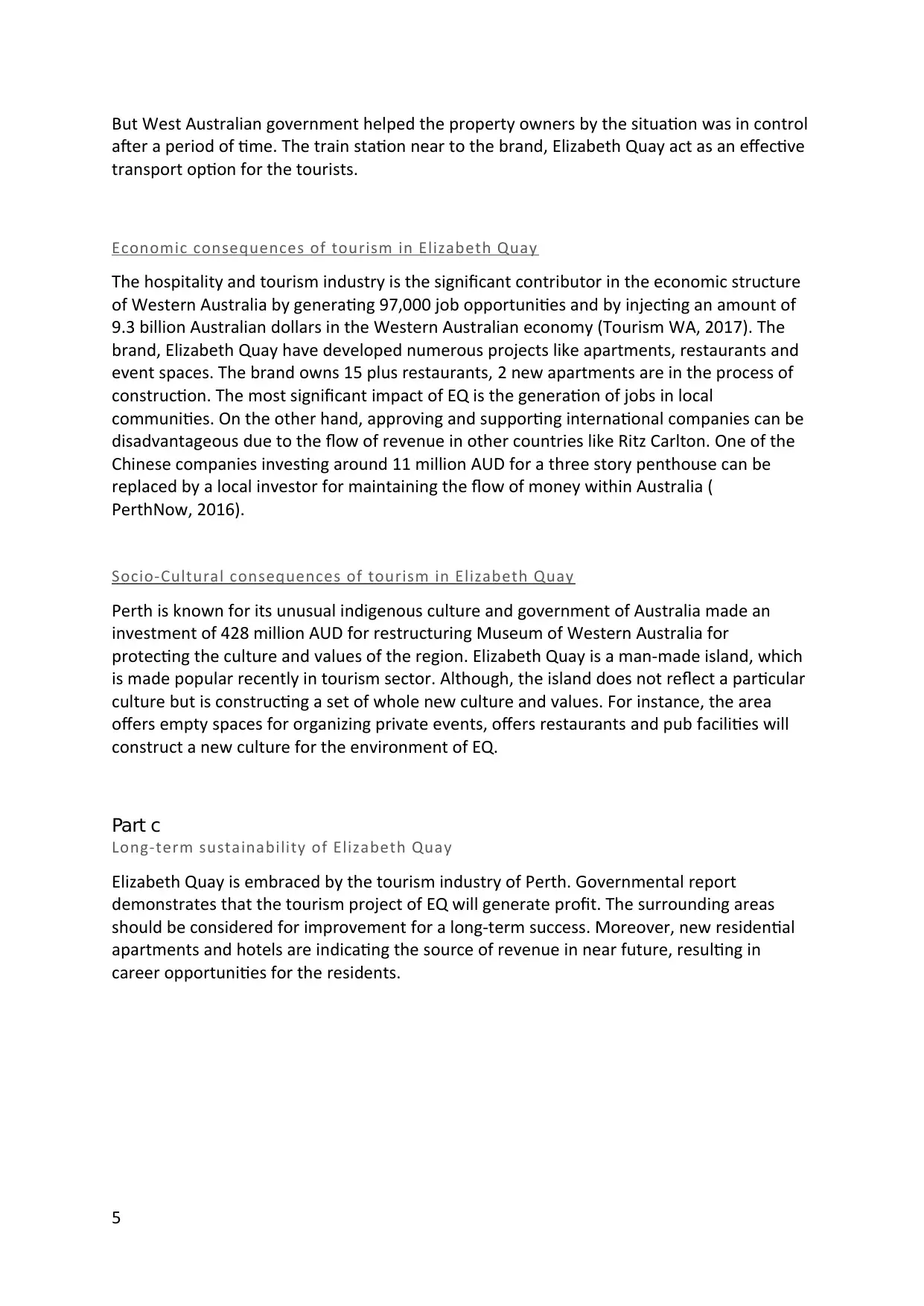
But West Australian government helped the property owners by the situation was in control
after a period of time. The train station near to the brand, Elizabeth Quay act as an effective
transport option for the tourists.
Economic consequences of tourism in Elizabeth Quay
The hospitality and tourism industry is the significant contributor in the economic structure
of Western Australia by generating 97,000 job opportunities and by injecting an amount of
9.3 billion Australian dollars in the Western Australian economy (Tourism WA, 2017). The
brand, Elizabeth Quay have developed numerous projects like apartments, restaurants and
event spaces. The brand owns 15 plus restaurants, 2 new apartments are in the process of
construction. The most significant impact of EQ is the generation of jobs in local
communities. On the other hand, approving and supporting international companies can be
disadvantageous due to the flow of revenue in other countries like Ritz Carlton. One of the
Chinese companies investing around 11 million AUD for a three story penthouse can be
replaced by a local investor for maintaining the flow of money within Australia (
PerthNow, 2016).
Socio-Cultural consequences of tourism in Elizabeth Quay
Perth is known for its unusual indigenous culture and government of Australia made an
investment of 428 million AUD for restructuring Museum of Western Australia for
protecting the culture and values of the region. Elizabeth Quay is a man-made island, which
is made popular recently in tourism sector. Although, the island does not reflect a particular
culture but is constructing a set of whole new culture and values. For instance, the area
offers empty spaces for organizing private events, offers restaurants and pub facilities will
construct a new culture for the environment of EQ.
Part c
Long-term sustainability of Elizabeth Quay
Elizabeth Quay is embraced by the tourism industry of Perth. Governmental report
demonstrates that the tourism project of EQ will generate profit. The surrounding areas
should be considered for improvement for a long-term success. Moreover, new residential
apartments and hotels are indicating the source of revenue in near future, resulting in
career opportunities for the residents.
5
after a period of time. The train station near to the brand, Elizabeth Quay act as an effective
transport option for the tourists.
Economic consequences of tourism in Elizabeth Quay
The hospitality and tourism industry is the significant contributor in the economic structure
of Western Australia by generating 97,000 job opportunities and by injecting an amount of
9.3 billion Australian dollars in the Western Australian economy (Tourism WA, 2017). The
brand, Elizabeth Quay have developed numerous projects like apartments, restaurants and
event spaces. The brand owns 15 plus restaurants, 2 new apartments are in the process of
construction. The most significant impact of EQ is the generation of jobs in local
communities. On the other hand, approving and supporting international companies can be
disadvantageous due to the flow of revenue in other countries like Ritz Carlton. One of the
Chinese companies investing around 11 million AUD for a three story penthouse can be
replaced by a local investor for maintaining the flow of money within Australia (
PerthNow, 2016).
Socio-Cultural consequences of tourism in Elizabeth Quay
Perth is known for its unusual indigenous culture and government of Australia made an
investment of 428 million AUD for restructuring Museum of Western Australia for
protecting the culture and values of the region. Elizabeth Quay is a man-made island, which
is made popular recently in tourism sector. Although, the island does not reflect a particular
culture but is constructing a set of whole new culture and values. For instance, the area
offers empty spaces for organizing private events, offers restaurants and pub facilities will
construct a new culture for the environment of EQ.
Part c
Long-term sustainability of Elizabeth Quay
Elizabeth Quay is embraced by the tourism industry of Perth. Governmental report
demonstrates that the tourism project of EQ will generate profit. The surrounding areas
should be considered for improvement for a long-term success. Moreover, new residential
apartments and hotels are indicating the source of revenue in near future, resulting in
career opportunities for the residents.
5
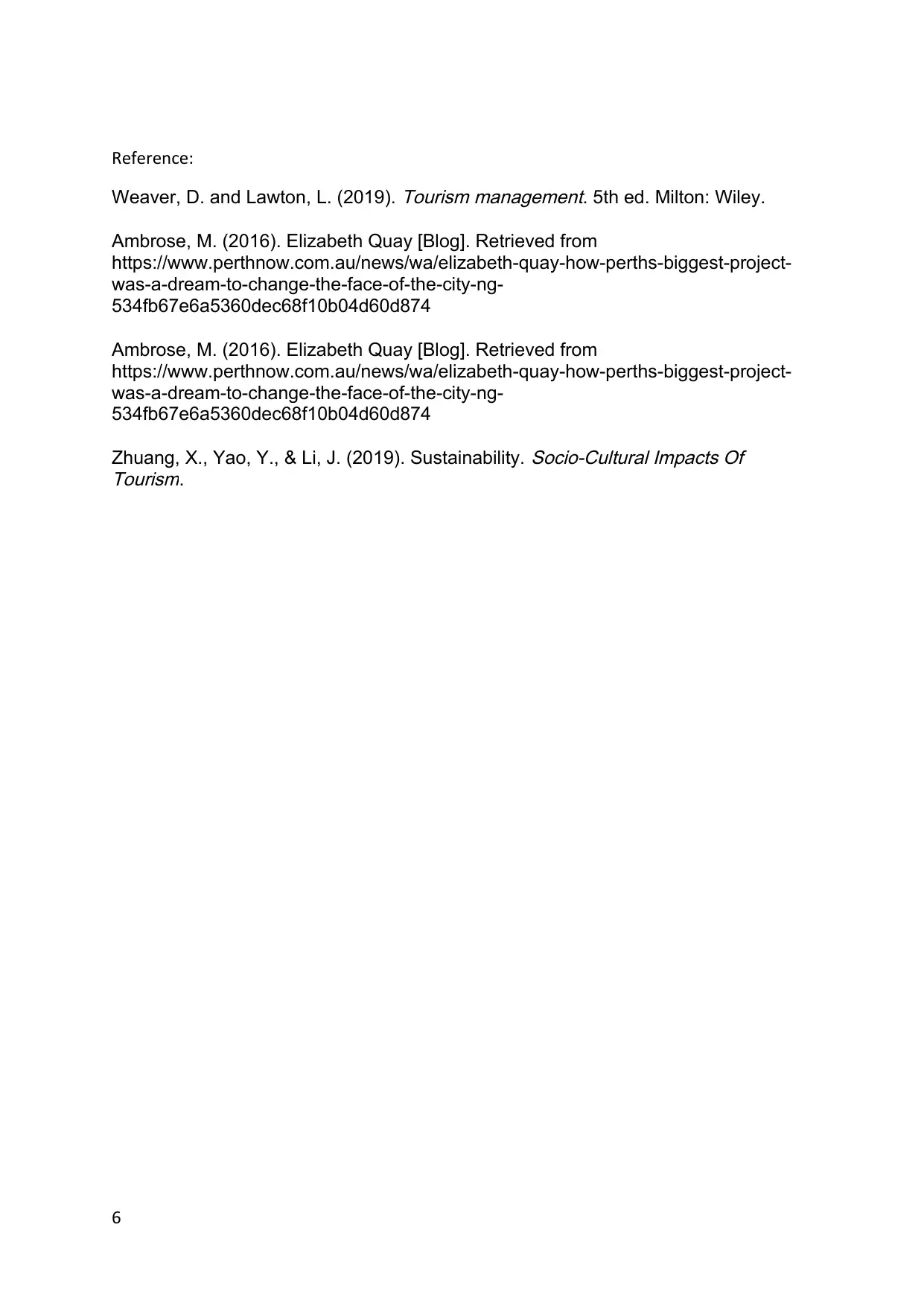
Reference:
Weaver, D. and Lawton, L. (2019).
Tourism management. 5th ed. Milton: Wiley.
Ambrose, M. (2016). Elizabeth Quay [Blog]. Retrieved from
https://www.perthnow.com.au/news/wa/elizabeth-quay-how-perths-biggest-project-
was-a-dream-to-change-the-face-of-the-city-ng-
534fb67e6a5360dec68f10b04d60d874
Ambrose, M. (2016). Elizabeth Quay [Blog]. Retrieved from
https://www.perthnow.com.au/news/wa/elizabeth-quay-how-perths-biggest-project-
was-a-dream-to-change-the-face-of-the-city-ng-
534fb67e6a5360dec68f10b04d60d874
Zhuang, X., Yao, Y., & Li, J. (2019). Sustainability.
Socio-Cultural Impacts Of
Tourism.
6
Weaver, D. and Lawton, L. (2019).
Tourism management. 5th ed. Milton: Wiley.
Ambrose, M. (2016). Elizabeth Quay [Blog]. Retrieved from
https://www.perthnow.com.au/news/wa/elizabeth-quay-how-perths-biggest-project-
was-a-dream-to-change-the-face-of-the-city-ng-
534fb67e6a5360dec68f10b04d60d874
Ambrose, M. (2016). Elizabeth Quay [Blog]. Retrieved from
https://www.perthnow.com.au/news/wa/elizabeth-quay-how-perths-biggest-project-
was-a-dream-to-change-the-face-of-the-city-ng-
534fb67e6a5360dec68f10b04d60d874
Zhuang, X., Yao, Y., & Li, J. (2019). Sustainability.
Socio-Cultural Impacts Of
Tourism.
6
⊘ This is a preview!⊘
Do you want full access?
Subscribe today to unlock all pages.

Trusted by 1+ million students worldwide
1 out of 6
Related Documents
Your All-in-One AI-Powered Toolkit for Academic Success.
+13062052269
info@desklib.com
Available 24*7 on WhatsApp / Email
![[object Object]](/_next/static/media/star-bottom.7253800d.svg)
Unlock your academic potential
Copyright © 2020–2025 A2Z Services. All Rights Reserved. Developed and managed by ZUCOL.


